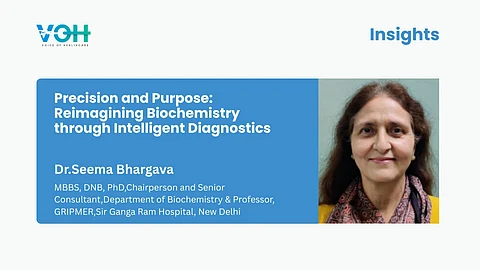

In the early 1960s satellites were circling our planet, President Kennedy had committed the US to put a man on the moon by the end of the decade, and graduate students in the Department of Biochemistry of the University of Tennessee were making predictions on the future of analysis (mostly manual at the time) of body fluids. Over a pitcher of cold beer on a hot and humid summer day, one of us dared to predict that someday there would be instruments in which you could put serum or even whole blood at one end and get the results at the other; ‘printed too,’ concluded the optimist of the group”. This description by Doumas actually emphasizes the rapid technological advances in laboratory medicine.
Medical testing laboratories have been regarded as the backbone of management in clinical medicine. While other sections of diagnostic laboratories deal with detection of normal and abnormal cells and organisms, Biochemistry deals with detecting and quantifying normal and abnormal molecular constituents of body fluids. Hence technology has impacted Biochemistry more than any other section of clinical pathology. Since ours is the impending global capital of diabetes, let us consider the example of the simplest ingredient of body fluids that is detected in the Biochemistry laboratory and used for diagnosis and management of diabetes – glucose. The earliest reports of sugar in urine were by an ancient Indian physician who called it ‘madhumeha’. It was only in 1776, however, that methods to detect sugars in urine were established. Over the next two centuries the methods got refined from the semi-quantitative Benedict’s test (1908) which detected all sugars to Folin Wu’s (1919) method which detected and quantified only reducing sugars. By this time visual colour quantification had been replaced by colorimetry. Then methodology evolved to specific glucose detection by glucose-oxidase-peroxidase while instrumentation evolved to automated analysers. These further evolved to methods with increased specificity (hexokinase), reduced variation, highly increased precision and reduced sample requirement. Yet further evolution led to the glucometer, one of the first of point-of-care testing devices.
Thus far, only the in vitro diagnostic methods for detecting glucose have been addressed, but today, in vivo glucose monitors are available (viz. flash monitor, continuous glucose monitor) which measures the available glucose in the patient’s capillary system at predefined intervals![5]
This example demonstrates how evolution of diagnostic technologies results in the discipline of Biochemistry shifting from manual assays to intelligent, data-driven platforms. This transition demands not only technical adaptation but also a rethinking of how we define quality in laboratory medicine. Quality assurance in biochemistry is no longer confined to procedural checklists. Automation has enabled laboratories to streamline workflows, reduce human error, and enhance reproducibility while, at the same time, improving methodologies and reducing sample requirement. High-throughput random access systems now deliver results with remarkable speed and consistency, supporting clinicians in time-sensitive decision-making. However, contrary to the belief that automation reduces requirement of manpower, it actually mandates better qualifications, technological training and more experience amongst all levels of personnel manning the Biochemistry laboratories.
Artificial intelligence (AI) adds yet another layer of sophistication. Automated analysers now come with middleware to organise data of quality assurance procedures as well as patients’ samples. It enables the laboratories to manage resources by facilitating communications between required software applications and systems. Middleware is actually the foundation layer of connectivity and management, managing data and connections intelligently. They are programmable to identify situations requiring reflex testing and perform it too. It can also handle security protocols, authentication, and authorization However, that requires hours, days, weeks and months of brainstorming to decide what to program and what not to program, in which situations to use this facility and where to abolish it, whom to give access to decision making in such an instance and whom to bar from it – the list goes on and on! But a word of caution is very appropriate at this juncture and it has been best described by Aldous Huxley – “Technological progress has merely provided us with more efficient means for going backwards.” Hence, one may emphasize here that each variable that one adds to an algorithm may make the software much more modular and adaptable, but it can also lead to increased code volume, larger executables, increased memory consumption and potential for greater complexity, making it more vulnerable to crashing, especially in the outreaches of our country where even availability of round-the-clock supply of water and electricity is a challenge, to say nothing of the abilities of available personnel!
Tools like PubTator3, developed by the National Center for Biotechnology Information, use AI to annotate biomedical literature and unify bio-entities for knowledge discovery [2]. These technologies are beginning to assist in pattern recognition, anomaly detection, and predictive analytics - especially in complex biochemical profiles. The integration of AI must, however, be guided by clinical wisdom and ethical oversight. Algorithms can process data, but they cannot interpret context or understand the nuances of patient care. The biochemist’s role remains irreplaceable in ensuring that technology serves humanity, not the other way around. Literature offers timeless reminders of this balance. T.S. Eliot’s reflection— “Where is the wisdom we have lost in knowledge?”—resonates deeply in an era of information overload. Mary Shelley’s Frankenstein warns of science unmoored from responsibility, a cautionary tale for those who innovate without introspection. As educators and practitioners, we must cultivate a culture of care alongside a commitment to precision. Quality assurance in biochemistry must evolve into a holistic framework - one that honours both scientific rigor and human empathy. The future of diagnostics lies not only in what we build, but in how we choose to understand and apply it.